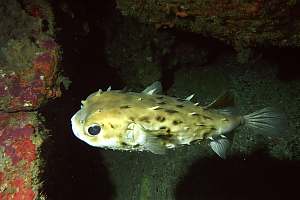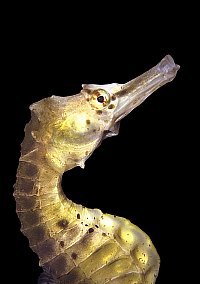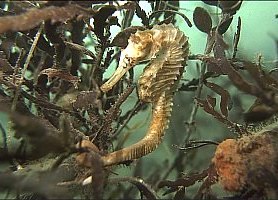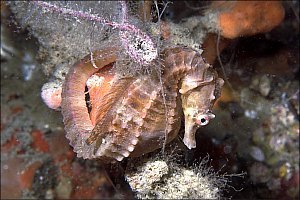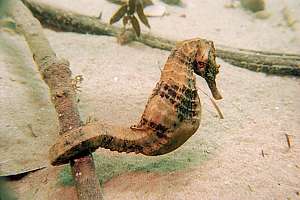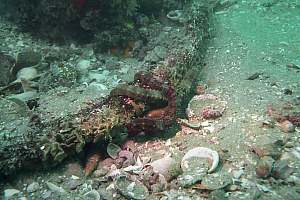The pufferfishes (Tetradontidae) all have cylindrical
shapes and are able to puff their bodies up with water. They do so by closing
a flap over their gills and gulping water down their mouths. It is so funny
seeing them do so.
Pufferfishes have sharp bony jaws with which they can
exert considerable force. Their skins have no scales. Most pufferfishes
are highly poisonous, especially their digestive organs. Although it is
possible by a skilled person to remove these organs without spilling their
contents, as is a customary in Japan, pufferfishes or any part thereof
should not be eaten. Their potent neuro-toxins have caused many deaths
of those who challenged this wisdom, and others who were ignorant of it.
Like triggerfishes and leatherjackets, pufferfishes do
not swim with their tails but with their dorsal and anal fins, which are
well set back on their bodies. This gives them the advantage of double
propulsion and high maneuverability. Pufferfishes can, with ease, swim
forward and backward, stand on their heads or tails, and so on, which allows
them to find food where others can't reach.
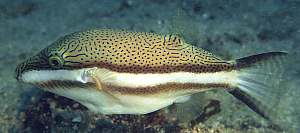 |
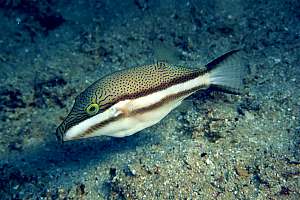 f024506: the sharp-nosed pufferfish or clown toado (Canthigaster
callisternus) is no more than 15cm long, but usually half the size
of one's hand. It is cute and intelligent. With its pointed snout and flexible
propulsion, it nibbles a bit here and there, often swimming far out into
the open sea in search of jellyfish. With its pointed snout, it can pierce
the jelly to reach the flavoursome and nutricious gonads inside. This little
darling is easy to catch at night when sleeping. Held in one's hand, it
then puffs itself up to a perfectly round ball, looking all the more funny
and endearing, with only its little tail and pointed nose sticking out.
It then waits for a moment of reduced attention, to deflate itself very
suddenly, and swim away into the vegetation where it disappears from sight
due to its disruptive coloration.
f024506: the sharp-nosed pufferfish or clown toado (Canthigaster
callisternus) is no more than 15cm long, but usually half the size
of one's hand. It is cute and intelligent. With its pointed snout and flexible
propulsion, it nibbles a bit here and there, often swimming far out into
the open sea in search of jellyfish. With its pointed snout, it can pierce
the jelly to reach the flavoursome and nutricious gonads inside. This little
darling is easy to catch at night when sleeping. Held in one's hand, it
then puffs itself up to a perfectly round ball, looking all the more funny
and endearing, with only its little tail and pointed nose sticking out.
It then waits for a moment of reduced attention, to deflate itself very
suddenly, and swim away into the vegetation where it disappears from sight
due to its disruptive coloration.
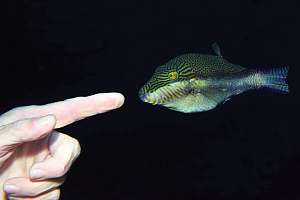 |
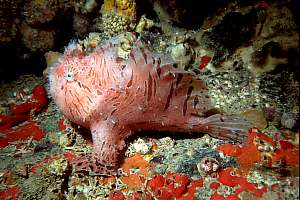
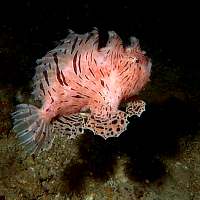
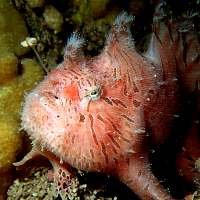



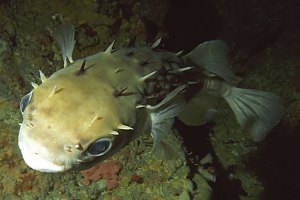 Porcupine
fishes have cute mouths consisting of strong bony plates with which they
can crush shellfish. Their large eyes can rotate freely to look forward
like mammals do, and backward as well.
Porcupine
fishes have cute mouths consisting of strong bony plates with which they
can crush shellfish. Their large eyes can rotate freely to look forward
like mammals do, and backward as well.